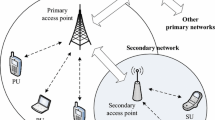Abstract
With the increasing demands for radio spectrum, techniques are being explored that would allow dynamic access of spectrum bands that are under-utilized. In this regard, a new paradigm called dynamic spectrum access is being investigated where wireless service providers (WSPs) would dynamically seek more spectrum from the under-utilized licensed bands when and where they need without interfering with the primary users. Currently, there is little understanding on how such a dynamic allocation will operate so as to make the system feasible under economic terms. In this paper, we consider the dynamic spectrum allocation process where multiple WSPs (bidders) compete to acquire necessary spectrum band from a common pool of spectrum. We use auction theory to analyze the allocation process when the demand from WSPs exceeds the available spectrum. We investigate various auction mechanisms under different spectrum allocation constraints to find WSPs’ bidding strategies and revenue generated by spectrum owner. We show that sequential bidding of bands provides better result than the concurrent bidding when WSPs are constrained to at most single unit allocation. On the other hand, when the bidders request for multiple units, (i.e., they are not restricted by allocation constraints) synchronous auction mechanism proves to be beneficial than asynchronous auctions.















Similar content being viewed by others
References
Aazhang B, Lilleberg J, Middleton G (2004) Spectrum sharing in a cellular system. In: IEEE 8th international symposium on spread spectrum techniques and applications. IEEE, Piscataway, pp 355–359
Buddhikot M, Kolodzy P, Miller S, Ryan K, Evans J (2005) DIMSUMnet: new directions in wireless networking using coordinated dynamic spectrum access. In: IEEE International symposium on a world of wireless, mobile and multimedia networks (WoWMoM). IEEE, Piscataway, pp 78–85
Buddhikot M, Ryan K (2005) Spectrum management in coordinated dynamic spectrum access based cellular networks. In: Proceedings of the first IEEE international symposium on new directions in dynamic spectrum access networks (DySpan). IEEE, Piscataway, pp 299–307
Illing G, Kluh U (2003) Spectrum auctions and competition in telecommunications. MIT, London
Kelly FP, Maulluo AK, Tan DKH (1998) Rate control in communication networks: shadow prices, proportional fairness and stability. J Oper Res Soc 49:237–252
MacKic-Mason IK, Varian HR (1995) Pricing congestible network resources. IEEE J Sel Areas Commun 13(7):1141–1149
Maille P, Tuffin B (2003) The progressive second price mechanism in a stochastic environment. Netnomics 5(2):119–147
Maille P, Tuffin B (2004) Multibid auctions for bandwidth allocation in communication networks. INFOCOM 1:54–65
Rodriguez V, Moessner K, Tafazolli R (2005) Market-driven dynamic spectrum allocation: optimal end-user pricing and admission control for CDMA. In: Proc. 14th European information society technologies (IST) mobile and wireless communications summit. Dresden, June 2005
Rodriguez V, Moessner K, Tafazolli R (2005) Auction driven dynamic spectrum allocation: optimal bidding, pricing and service priorities for multi-rate, multi-class CDMA. In: IEEE 16th international symposium on personal, indoor and mobile radio communications (PIMRC), vol 3. IEEE, Piscataway, pp 1850–1854
Sallent O, Perez-Romero J, Agusti R, Giupponi L, Kloeck C, Martoyo I, Klett S, Luo J (2006) Resource auctioning mechanisms in heterogeneous wireless access networks. In: IEEE 63rd vehicular technology conference, VTC 2006-Spring, vol 1. IEEE, Piscataway, pp 52–56
Semret N (1999) Market mechanisms for network resource sharing. Ph.D. dissertation, Columbia University
Sengupta S, Chatterjee M (2007) Sequential and concurrent auction mechanisms for dynamic spectrum access. In: IEEE/CreateNet CrownCom, Miami, 1–3 August 2007
Sengupta S, Chatterjee M (2006) Synchronous and asynchronous auction models for dynamic spectrum allocation. In: International conference on distributed computing and networking (ICDCN). Indian Institute of Technology Guwahati, Guwahati, pp 558–569
Song KB, Chung ST, Ginis G, Cioffi JM (2002) Dynamic spectrum management for next-generation DSL systems. IEEE Commun Mag 40(10):101–109
Vickrey W (1961) Couterspeculation, auctions, and competitive sealed tenders. J Finance 16(1):8–37
Webb W, Marks P (1996) Pricing the ether [radio spectrum pricing]. IEEE Rev 42(2):57–60
Author information
Authors and Affiliations
Corresponding author
Rights and permissions
About this article
Cite this article
Sengupta, S., Chatterjee, M. Designing Auction Mechanisms for Dynamic Spectrum Access. Mobile Netw Appl 13, 498–515 (2008). https://doi.org/10.1007/s11036-008-0081-1
Received:
Accepted:
Published:
Issue Date:
DOI: https://doi.org/10.1007/s11036-008-0081-1




